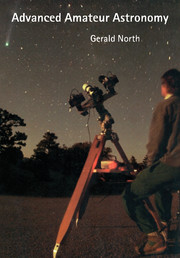Book contents
- Frontmatter
- Contents
- Preface to the second edition
- Preface to the first edition
- Acknowledgements
- 1 Telescope optics
- 2 Atmosphere, seeing, magnification and eyepieces
- 3 Telescope hardware and adjustments
- 4 Astrophotography with the camera
- 5 Astrophotography through the telescope
- 6 Electronic imaging
- 7 The Moon
- 8 The terrestrial planets
- 9 The gas-giant planets
- 10 Asteroids, comets, meteors and aurorae
- 11 The Sun
- 12 Variable stars and novae
- 13 Methods of photometry
- 14 Double stars, star clusters, nebulae, galaxies and supernovae
- 15 Spectroscopy
- 16 Radio astronomy
- 17 Further information
- Appendix: Useful formulae
- Index
2 - Atmosphere, seeing, magnification and eyepieces
Published online by Cambridge University Press: 04 August 2010
- Frontmatter
- Contents
- Preface to the second edition
- Preface to the first edition
- Acknowledgements
- 1 Telescope optics
- 2 Atmosphere, seeing, magnification and eyepieces
- 3 Telescope hardware and adjustments
- 4 Astrophotography with the camera
- 5 Astrophotography through the telescope
- 6 Electronic imaging
- 7 The Moon
- 8 The terrestrial planets
- 9 The gas-giant planets
- 10 Asteroids, comets, meteors and aurorae
- 11 The Sun
- 12 Variable stars and novae
- 13 Methods of photometry
- 14 Double stars, star clusters, nebulae, galaxies and supernovae
- 15 Spectroscopy
- 16 Radio astronomy
- 17 Further information
- Appendix: Useful formulae
- Index
Summary
The Earth's atmosphere poses a constant problem to the work of the astronomer. Not only does it absorb much of the radiation arriving from space; it also limits the fineness of detail that can be resolved by a telescope.
Atmospheric turbulence
Temperature gradients cause convective cells to develop in the atmosphere from ground level up to a height of about 7 km. These swirling pockets of air of differing density (and so differing refractive index) disturb the light arriving from space. The arriving rays suffer small changes in direction, as a result. The convective cells typically have diameters ranging from 10 to 20 cm. It is the motion of these in the line of sight of an observer that causes the stars to appear to flash and twinkle (or scintillate).
The effect that scintillation has on the image formed by a telescope partly depends on the size of that telescope. If it has an aperture not much bigger than the prevalent size of the convective air cells, then the image of a star will remain fairly sharply focused but will perambulate around its mean position in the focal plane. If the aperture of the telescope is much larger, then a number of different convective cells contribute their random effects to the light arriving at the telescope at any given time. The star image will then be less mobile but will be blurred out into a seeing disc roughly equal in radius to the amplitude of the motions as seen in the smaller telescope.
- Type
- Chapter
- Information
- Advanced Amateur Astronomy , pp. 27 - 41Publisher: Cambridge University PressPrint publication year: 1997



